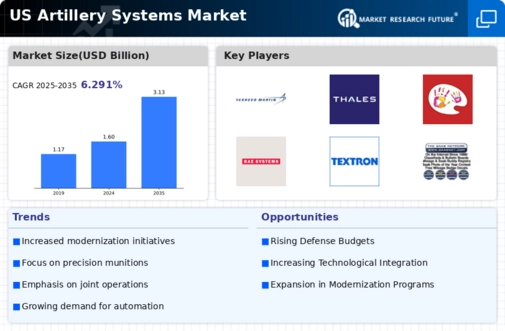Technological Integration and Automation
The integration of advanced technologies into artillery systems is a key driver for the artillery systems market. Innovations such as automation, artificial intelligence, and precision-guided munitions are transforming traditional artillery operations. The US military is increasingly adopting these technologies to enhance accuracy and reduce response times. For instance, the implementation of automated fire control systems is expected to improve operational efficiency by up to 30%. This technological evolution not only increases the effectiveness of artillery units but also reduces the risk to personnel. As the artillery systems market embraces these advancements, manufacturers are likely to invest heavily in research and development to create next-generation systems that meet the demands of modern combat scenarios.
Emerging Threats and Geopolitical Tensions
The artillery systems market is experiencing growth due to emerging threats and geopolitical tensions. Nations are increasingly investing in advanced artillery systems to enhance their military capabilities in response to regional conflicts and potential adversaries. The US defense strategy emphasizes deterrence, leading to a projected increase in artillery procurement. In 2025, the US military's budget allocation for artillery systems is expected to rise by approximately 10%, reflecting the urgency to modernize and expand capabilities. This trend indicates a robust demand for advanced artillery systems, as military planners prioritize effective long-range strike capabilities to address evolving threats. The artillery systems market is thus positioned to benefit from these strategic shifts, as defense contractors innovate to meet the requirements of modern warfare.
Increased Military Collaborations and Alliances
The artillery systems market is being driven by increased military collaborations and alliances among nations. The US has been actively engaging in joint exercises and defense agreements with allied countries, which often include artillery training and equipment sharing. This collaborative approach enhances interoperability and strengthens collective defense capabilities. In 2025, the US is expected to allocate approximately $2 billion for joint artillery programs with NATO allies, reflecting a commitment to shared defense initiatives. Such collaborations not only bolster the capabilities of participating nations but also stimulate demand for advanced artillery systems within the market. The artillery systems market is thus likely to see growth as countries seek to align their artillery capabilities with those of their allies.
Sustainment and Lifecycle Management Initiatives
Sustainment and lifecycle management initiatives are becoming increasingly important in the artillery systems market. The US military is focusing on extending the operational life of existing artillery systems while ensuring they remain effective and relevant. This approach involves regular upgrades, maintenance, and the integration of new technologies into legacy systems. In 2025, the US is expected to invest around $1.5 billion in sustainment programs for its artillery fleet, highlighting the importance of lifecycle management in maintaining readiness. The artillery systems market is likely to benefit from this trend, as manufacturers provide solutions that enhance the longevity and performance of artillery systems. This focus on sustainment not only ensures operational efficiency but also contributes to cost savings in the long run.
Focus on Counterinsurgency and Asymmetric Warfare
The artillery systems market is influenced by a growing focus on counterinsurgency and asymmetric warfare strategies. The US military is adapting its artillery capabilities to address unconventional threats posed by non-state actors and insurgent groups. This shift necessitates the development of lighter, more mobile artillery systems that can be deployed rapidly in diverse environments. In 2025, the demand for such systems is projected to increase by 15%, as military planners recognize the need for flexibility in modern combat. The artillery systems market is responding to this demand by innovating solutions that enhance mobility and effectiveness in counterinsurgency operations. This trend indicates a significant transformation in the types of artillery systems being developed and procured.






















Leave a Comment